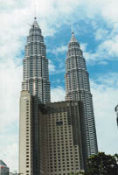International
Upstream climate brightening in Southeast AsiaJAKARTA-Just two weeks after the Indonesian parliament selected the country’s new president and vice president, it is hard to believe that this city was the site of numerous riots and demonstrations while the process was underway. Scanning the view around town, an eerie calm and sense of "business as usual" pervades. Indonesians seem exhausted by the turmoil of the last 18 months – they look forward to a period of relative tranquility under new President Abdurrahman Wahid and Vice President Megawati Sukarnoputri. There is a sense that it is time to get on with day-to-day business. Indeed, all of Southeast Asia seems to be awakening from the economic slumber induced by the financial crisis that hit in 1997. Cautious optimism is beginning to sprout in several countries, and in the regional E&P industry. The benefits of higher oil prices came too late to alter 1999 budgets, but the picture is brighter for 2000. Capital investment for E&P should exceed 1999 outlays in most countries. As this is being written, your humble editor is in the final leg of a 17-day tour of Southeast Asia. What follows are initial impressions of the E&P climate in several countries. Indonesia. Parliament’s election of Wahid and Megawati has cooled enflamed passions that spread among citizens during October. As soon as Megawati, originally a presidential contender, was elected vice president, her enraged supporters quickly ended their riot-spawning demonstrations in Jakarta. Now, all the political parties / factions seem to be sufficiently mollified by this arrangement. More importantly, the Wahid / Megawati team appears to be making all the right decisions, both politically and economically. This is good news for an E&P industry that has been nervous ever since former strongman Soeharto was forced to resign the presidency in May 1998. After drilling 991 wells in 1997 and 1,015 in 1998, Pertamina and the foreign oil companies are on a path to drill about 970 wells in 1999. This will be the lowest total since 1996, but it certainly is not the serious decline registered in other parts of the world. Early prognosis for 2000 is that drilling will improve toward 1998’s level. Pertamina said it expects capital investment for E&P to rebound next year. Spending on projects fell 9.2% to $5.56 billion in 1999, from $6.12 billion in 1998. Natural gas is playing an increasingly larger role in field development plans. For instance, Conoco is developing several gas fields in the West Natuna area, to fulfill a deal signed with Sembawang Gas during the last year to supply an initial 325 MMcfgd to Singapore and Malaysia by July 2001. Construction of a new, $135-million, purpose-built production jackup begins in January, as does the laying of a 300-mi, $400-million pipeline from the West Natuna fields to Singapore. Thailand. This constitutional monarchy is one of Asia’s most stable countries. Prime Minister Chuan Leekpai first served in this position from May 1992 to May 1995 as head of the Democratic Party. In November 1997, he regained the PM position as head of a coalition that retains power today. Chuan’s return as PM was triggered by the Asian financial crisis, which began when Thailand floated its currency, the baht, in July 1997. The Thai economy shrank 9.4% in 1998. The U.S. State Department predicts modest recovery for 1999, to be followed by greater growth in 2000. The E&P industry in this gas-prone country outperformed the overall economy in 1998, with wells drilled rising 16%, from 192 in 1997. For 1999, the final count should be close to 1998’s figure. Activity in 1998 was boosted by dominant operator Unocal’s development of Pailin gas field (five platforms installed and 45 wells drilled). Elsewhere, Unocal pursues a steady "just in time" strategy for developing additional gas fields. Chevron entered Thailand in December 1998 by purchasing Rutherford Moran Oil Corp. Together with Pogo Producing, Chevron put a second gas / condensate field, Benchamas / Pakarong, onstream during July 1999 in the B8-32 offshore tract. Initial development plans are being drawn already for two additional fields in B8-32. Malaysia. In various incarnations, the dominant 14-party coalition known as Barisan Nasional has controlled Malaysia’s government since the nation gained independence in 1957. In the last general election in 1995, Barisan Nasional won an overwhelming majority – 162 out of 192 parliamentary seats.
After a decade of strong economic growth that averaged 8.7% annually, Malaysia was hit hard by the Asian crisis. However, a recovery appears underway. Upstream work is dominated by state firm Petronas and Esso Malaysia, and has been stable despite see-sawing oil prices. On average, six rigs drill 60 to 70 wells annually. Petronas’ strategy is to keep oil output from slipping below 600,000 bpd, so new projects are geared to that goal. Officials are not happy with a 36% average oil recovery rate, so they hope to utilize new technologies to boost the rate to 41%. Natural gas is playing a larger role. Reasons include expanding industrial usage, gas discoveries are outnumbering oil finds, and new oil pockets are becoming smaller. Special note. Beginning
next month, World Oil will run a series of articles that profile individual
Southeast Asian nations. The series also will examine noteworthy projects and application of
technologies to improve operations. Copyright © 1999 World
Oil |




